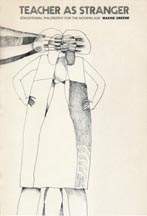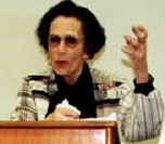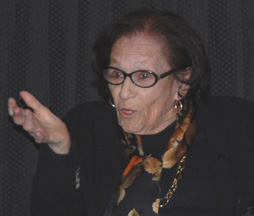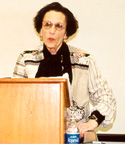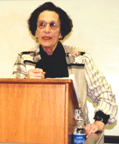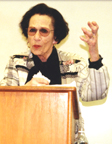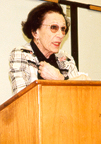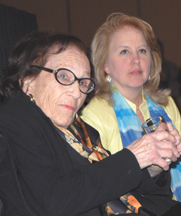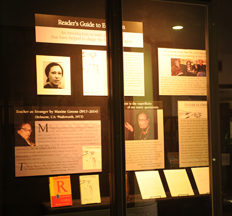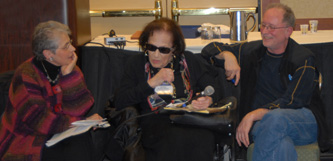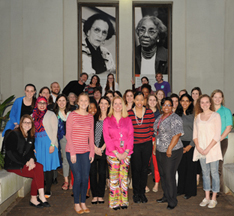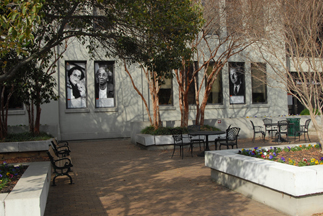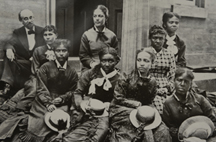

Books of the 20th Century Exhibition |
||||||||||||||||||
Teacher as Stranger: by Maxine Greene (1917–2014) |
|
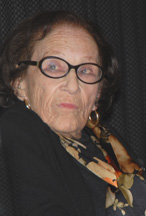 Maxine Greene, 2008 |
||||||||||||||||
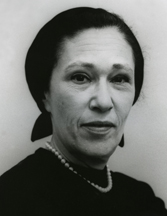 |
Doing philosophy with Maxine Greene “could be––had to be––both exhausting and exhilarating. Keeping up was the first challenge: she is a person on whom nothing is lost, an intensely observant person, vigorous as well as open in pursuing what is there to be seen. She sees largely what narrower minds miss, and sees particularity in vivid, nuanced detail” (Ayers, 1996, p. 120). Maxine Greene has given the field of education many powerful phrases and publications–– Landscapes of Learning (1978); Releasing the Imagination (1995); “creating possibilities”; “towards wide-awakeness”; The Dialectic of Freedom (1988); and, one of our favorites, The Public School and the Private Vision (1965). For our exhibition, however, we highlight Teacher as Stranger––a work that, while not overlooked, must be considered a somewhat rare and, alas, unread work within the Greene literature. |
|||||||||||||||||
|
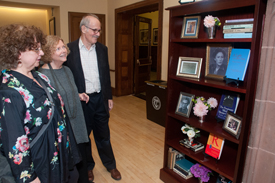 Comments from the Maxine Greene Memorial Celebration October 6, 2014; Teachers College Photo credit: Heather Van Uxem Lewis Teachers College, Columbia University |
|||||||||||||||||
|
||||||||||||||||||
|
||||||||||||||||||
It seems to me now, however, that the impact of the sixties was strong: the civil rights movement, the anti-war protests, local educational struggles all struck me as philosophically challenging as they were politically important. I marched very often, worked anonymously and locally for better schools, for humane bussing, and the like. There were moments of unprecedented freedom, other moments of significant membership in new communities. I wanted to introduce some of what I was learning into philosophical discourse and, yes, into the schools. When I look back and find the book beginning with the film, Easy Rider, and its evocation of books about the American quest, of later “road” stories, of a looming darkness (linked, even then, to drugs and violence), I see the book somewhat “other” than when I wrote it. I was making an effort to be “marginal” and to make as clear as I could my own perspective. I am pleased retrospectively that I prefaced the text with some words about my own way of seeing and feeling: coming from the city, reading The New Yorker and The New York Review of Books and The Nation. I do not think I was flaunting my urban sophistication. I tried to make clear the limitations of such a vision (unacquainted with some of the rituals and practices that, for so many people, define “America”) and my realization of the gulf between me and some of my readers. |
||||||||||||||||||
|
||||||||||||||||||
I came upon the title, Teacher as Stranger after reading an essay by the social phenomenologist, Alfred Schutz, called “The Stranger” (1964). Schutz described what it was like when someone approaches a group new to her/him with a set of “recipes” ordinarily used to make sense of things. The newcomer, the outsider finds the group she/he is approaching to be entirely unfamiliar and even questionable in its dominant ways of being; and the outsider’s adaptation to the group becomes “a continuing process of inquiry.” It is not possible to take for granted as normal what the in-group scarcely notices because it is so ordinary, so unchanging. Identifying the teacher with a stranger, I had in mind a practitioner who would notice, pay attention, ask critical questions in a way seldom done by someone so accustomed to the situation that its very familiarity obscured the details. My idea was that a teacher who first approached a class as a stranger in Schutz’s sense might remain wide-awake and critical of what surrounded her/him, more given to noticing and responding to what might be smothered by the taken-for-granted. |
||||||||||||||||||
“To take a stranger’s point of view on everyday reality is to look inquiringly and wonderingly on the world in which one lives. It is like returning home from a long stay in some other place.” |
|
|||||||||||||||||
The use of a rather dated division of philosophy of education into analytic, experiential, and existential approaches would not work very well today; and I probably would not break my discussion up in such a fashion. As in the case of many definitions and boundaries (in and outside of the fields of education) the constructs I have used suggest a kind of objective reality in each area that, I am afraid, falsifies the different moments. I think I could have clarified the different modes of attention that marked different philosophers’ bodies of work without insisting on the familiar categories. I would, working today, use Richard Rorty, Charles Taylor, and Alastair MacIntyre as sources, as I would turn in places to Martha Nussbaum and even Hannah Arendt. Many of these would be relatively unclassifiable today. To put it in other words, the singularity of each philosopher seems to be partly lost when the reader is asked to know a thinker by the so-called “movement” to which she/he belongs. And, yes, whether or not I would today want to include philosophers thought of as “post-modern,” those considered “post-structuralist,” neo-Marxist, and the rest. Even as I write that, I am haunted by images of roads, of random destruction, of persons in quest. I am given, in fact, to think of human beings as beings marked by the desire to search, to reach beyond, and in—and by means of the reaching—create projects that enable them to choose identities. Of course, this viewing, this metaphor is intended to infuse “my” educational philosophy. |
||||||||||||||||||
There is too the superfluity of my many quotations. One reviewer, pointing to the allusions made in the book, wrote that a search for my referents was like picking up hubcaps on the Indianapolis Speedway. I am fairly sure that my apparent dependence on them was due to a kind of fear and a need to hide (as a woman) behind the writings of respectable “white” men. That may be partially true, although I cannot remember deliberately selecting quotations with that in mind. I have always wanted to make the point that a quote from Camus, say, or Woolf, or Ellison would simply surge up in my mind without necessarily looking them up or deliberately hunting for support. I know I try to do that less; but I am fairly sure that the quotes and references are in part due to my feeling myself to be part (perhaps a humble part) of the ongoing conversation that helps create western culture. And, of course, they are partly occasioned by my desire to move educators of many sorts beyond technical reading to what some are calling “liberal learning” or even, succinctly, “great books.” I must immodestly say that more people have been writing to me asking for a new edition, saying that the book inspired them to teach in new ways, reminding me that I have wanted to make teachers’ lives “harder,” not easier, not more ordinary. I still have to determine (and am trying to determine) how and if the causes of the sixties (and sometimes of the Thirties) connect with the questions we must ask today. Students today seem inspired by the causes that somehow come to the surface in my book; and although I realize that the world of free markets, pluralization, and cyberspace is not the world of capitalist-communist rivalry (with all its visions of the great “Satan”), that wars now occurring differ from the Vietnamese War and the devastation of Cambodia, that is more and more difficult to think of actions to be undertaken, I still hope that the teaching project itself can become a humane cause. I hope a commitment to it will signify, at least to some, an engagement with social justice as well as wide-awakeness, and a passion for transforming the world.
|
||||||||||||||||||
William C. Ayers (1996). “Doing Philosophy: Maxine Greene and the Pedagogy of Possibility,” in Teachers and Mentors, edited by C. Kridel, et. al. (New York: Garland), pp. 117-126.
|
Craig Kridel, editor/arrayer (2000).
|
to return to the |
||||||||||||||||


an institutional member of the International Coalition of Sites of Conscience
Museumofed@gmail.com

